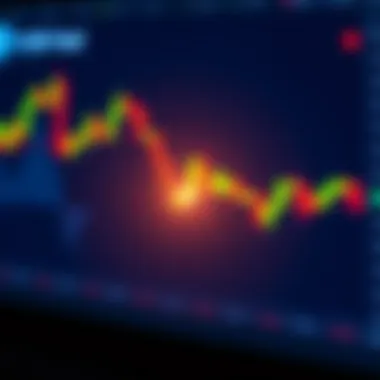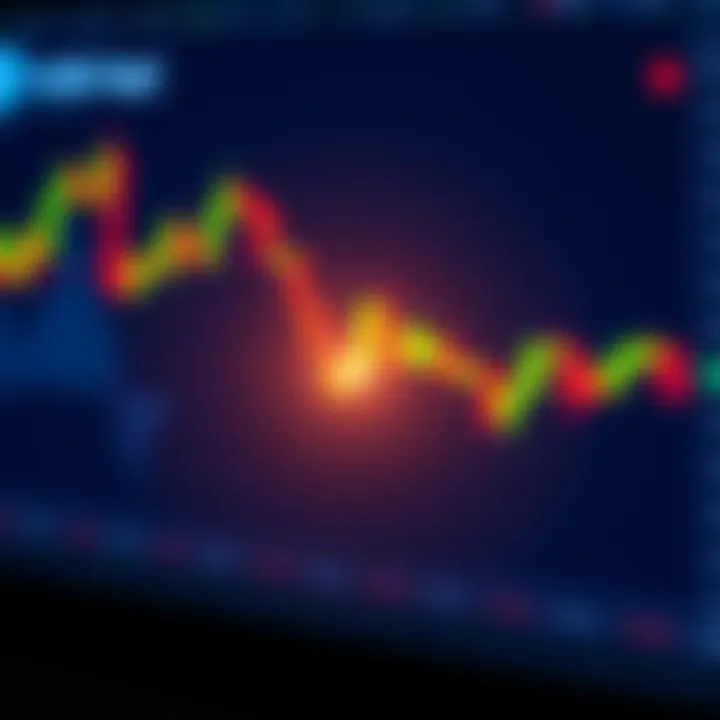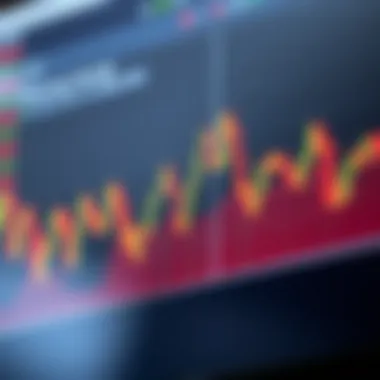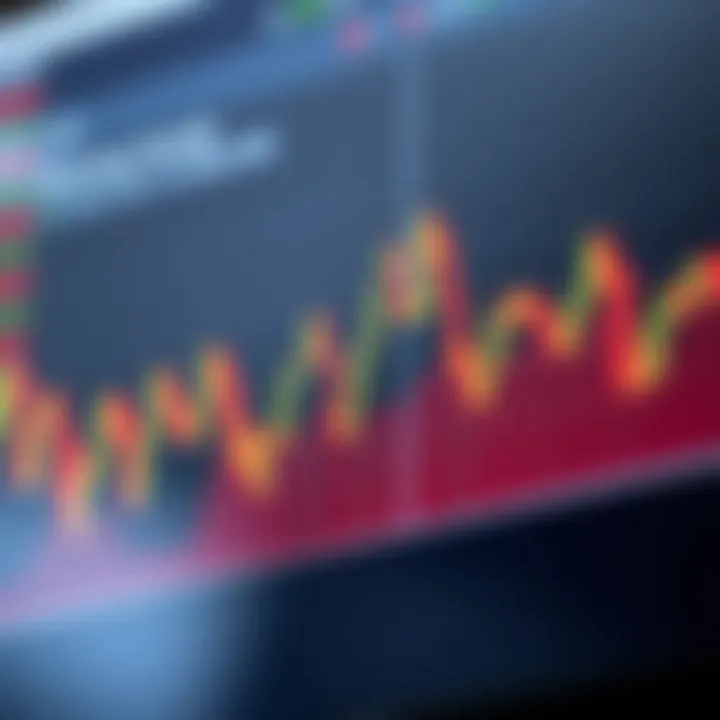Top Short Term Trading Indicators for Success


Intro
Navigating the world of short-term trading can feel like walking through a minefield, especially with the multitude of options available. For traders looking to make quick profits, short-term trading indicators are essential tools in their arsenal. These indicators serve as signposts, guiding traders through the unpredictable terrain of financial markets. Understanding their functions and how they can be applied in real-world scenarios is critical for success.
This article aims to unwrap the complexities surrounding short-term trading indicators. From comprehending key terms to examining the various strategies employed, we will take a deep dive into the essentials of effective trading methods. Whether you are just stepping into the riveting arena of trading or you are a seasoned investor looking to refine your approach, having a firm grasp of these indicators can profoundly impact your trading decisions.
As we progress, we will discuss how to identify which indicators may align best with your unique trading style. The landscape of trading is constantly shifting, and understanding the tools at hand is vital in making informed decisions. So, let’s get started, shall we?
Understanding Short Term Trading
Short term trading is an essential concept in the world of finance that often becomes the cornerstone for many investors looking to capitalize on quick market movements. Grasping the nuances of short term trading isn't just beneficial; it's vital for anyone serious about their investments. This section lays the groundwork for understanding why short-term trading holds such significance in today's volatile markets.
Definition and Scope
Short term trading typically refers to buying and selling financial instruments within a relatively short timeframe, which could range from a few minutes to a few weeks. Unlike long term investing, which seeks to benefit from gradual market appreciation over months or years, short term trading capitalizes on price fluctuations and market inefficiencies. The scope of short term trading encompasses various instruments including stocks, commodities, and currencies, allowing traders to react swiftly to market changes.
"In short term trading, timing is everything – a second too late can mean missing a golden opportunity."
Understanding the definition and scope allows traders to position themselves effectively in the market, knowing when to enter or exit a position based on real-time data and technical indicators.
Key Characteristics of Short Term Trading
Understanding the characteristics of short term trading establishes a clearer picture of what makes it distinct from other trading styles. Here are some key elements to consider:
- Frequent Trading: Short term traders often execute numerous trades daily, aiming to benefit from minor price changes.
- Technical Analysis: This style heavily relies on charts and technical indicators rather than fundamentals to make trading decisions.
- Risk Management: A solid risk management strategy is crucial, as the rapid movements necessitate quick decision-making.
- Psychological Resilience: Short term trading can be emotionally taxing; being mentally prepared for ups and downs is key.
These characteristics underscore the need for traders to be agile, well-informed, and possess a keen understanding of market dynamics.
Common Strategies Employed
Engaging effectively in short term trading often requires a toolbox of strategies tailored to the trader’s specific needs and market conditions. Common strategies include:
- Day Trading: Traders purchase and sell securities within the same day, aiming to profit from minute price changes. This strategy requires real-time analysis and quick execution.
- Swing Trading: Traders hold positions for several days or weeks, capitalizing on short-term price shifts, which necessitates a good understanding of market trends.
- Scalping: A strategy focused on making small profits off numerous trades, often involving high volumes and minimal holding times.
- Momentum Trading: Traders look for stocks or assets moving significantly in one direction and aim to ride the trend as long as possible.
Understanding and mastering these strategies allows traders to effectively exploit the best opportunities presented in short term price movements. Each strategy has its own merits and requires a specific skill set, making it vital for traders to find the one that aligns with their goals and risk tolerance.
The Role of Indicators in Trading
Indicators serve as essential tools in the trader's toolbox, guiding decision-making processes in the complex world of financial markets. Their importance can't be overstated, especially in short term trading, where timing is everything. When every second counts, having reliable indicators can mean the difference between a profitable day and a financial misstep. Traders rely on indicators to interpret market movements, identify trends, and provide insights into potential future price actions.
What Are Trading Indicators?
Trading indicators are mathematical computations used to analyze market data. They combine historical prices and volumes to produce signals that traders can use to inform their strategies. Essentially, indicators serve as a second pair of eyes; they help in filtering out noise from the market to throw the spotlight on key trends.
There are various types of indicators, ranging from simple moving averages to more complex ones like the MACD or Bollinger Bands. Each is designed to provide a unique perspective on the market's behavior, helping traders identify entry and exit points effectively.
To put it simply, if you were at a party full of chatter, trading indicators help you hear the music that matters.
Importance of Indicators in Short Term Trading
In the fast-paced environment of short term trading, indicators become indispensable. Here are a few reasons why they are crucial:
- Real-Time Analysis: Indicators provide real-time data analysis, assisting traders in making swift decisions that can capitalize on market opportunities.
- Risk Management: Many indicators come with built-in risk metrics, aiding traders in managing their portfolios and minimizing potential losses.
- Clarity and Focus: With so much information available, indicators simplify complex data, allowing traders to focus on what really counts. They eliminate uncertainty, offering a sense of direction in a seemingly chaotic environment.
In short, the use of indicators is like having a compass in uncharted waters; they help navigate toward a profitable path.
Differentiating Between Leading and Lagging Indicators
Not all indicators are created equal. Understanding the difference between leading and lagging indicators is crucial for any trader looking to refine their strategy. Here's a closer look:
- Leading Indicators: These indicators attempt to predict future price movements by providing signals before a trend occurs. They include tools like the Stochastic Oscillator or Relative Strength Index (RSI). While they can be very useful, they often come with a higher risk of false signals.
- Lagging Indicators: In contrast, lagging indicators react to price movements after they have happened. They include moving averages and MACD. These tools help confirm trends, ensuring that traders are not getting ahead of themselves. However, they can also result in late entries and exits, which is a significant consideration in short term trading.


"Knowing when to use leading or lagging indicators can significantly enhance your trading strategy. It's not just about having tools; it's about knowing how and when to use them."
In summary, indicators are crucial in short term trading, offering insights and signaling potential opportunities. With a solid understanding of what indicators are, their importance in trading, and how to differentiate between leading and lagging ones, traders can enhance their ability to make informed decisions in the ever-changing market landscape. Relevant resources for further reading include Investopedia and NerdWallet.
Popular Short Term Trading Indicators
In the world of trading, the tools that help analyze market conditions are indispensable. Indicators serve as vital instruments that assist traders in making informed decisions. This section explores some of the most recognized short-term trading indicators. Understanding each of them can enormously enhance trading strategies, allowing traders to identify market trends, gauge momentum, and recognize potential reversals.
Moving Averages
Moving averages are central to technical analysis, providing clarity and positioning in a typically noisy market. Traders often use these indicators to smooth out price data and identify the direction of the trend.
Simple Moving Average (SMA)
The Simple Moving Average (SMA) is one of the oldest and most straightforward indicators. It calculates the average price of a security over a specific number of periods. That means it will total the closing prices over your chosen periods and divide that number by the period count. For instance, a 10-day SMA adds together the last 10 days’ closing prices and divides by 10.
One key characteristic of the SMA is its simplicity. This feature allows traders to quickly assess whether a security is in an uptrend or downtrend. However, while many appreciate its clarity, the SMA isn’t quick to react to recent price changes. This lag can make it less advantageous during volatile markets, potentially leading to missed opportunities.
A unique feature of SMA is its ability to highlight zone resistance and support levels. If the price is consistently above the SMA, this indicates an uptrend, while prices below signal a downtrend. Ultimately, the SMA serves as a foundational building block for various trading strategies, making it a popular choice for both novices and seasoned traders.
Exponential Moving Average (EMA)
In contrast to its simpler counterpart, the Exponential Moving Average (EMA) gives greater weight to the most recent prices, making it faster to respond to price changes. This aspect is particularly beneficial for day traders looking to capture quick opportunities.
The key characteristic of the EMA is its sensitivity. By reacting quickly to price movements, it can help identify the current market trend more accurately than SMA. Many traders prefer using EMA because it can significantly enhance entry and exit points in trades.
However, this sensitivity can also be a double-edged sword. While faster signals may seem attractive, they can also lead to more false signals, especially in choppy markets. Traders must be cautious to not jump the gun based on premature information.
Many utilize EMA in conjunction with other indicators or alongside additional confirmation signals to minimize risks. This blend often leads to improved trading strategies, proving the EMA’s worth in a trader’s toolkit.
Relative Strength Index (RSI)
The Relative Strength Index (RSI) is a momentum oscillator. It ranges from 0 to 100 and indicates whether a security is overbought or oversold. This is a crucial indicator for short term traders who want to capitalize on price reversals. When the RSI exceeds 70, it suggests an overbought condition, while values under 30 indicate an oversold state.
Adjusting the RSI settings may provide even deeper insights, allowing traders to create a customized approach that can cater to their specific strategies. Importantly, understanding the context is essential for leveraging the RSI effectively.
Bollinger Bands
Bollinger Bands consist of three lines: the middle band is an SMA, while the upper and lower bands represent standard deviations above and below the SMA. This indicator can identify volatility as well as overbought or oversold conditions. When the price reaches one of the outer bands, traders often interpret this as a potential signal to buy or sell.
This dynamic setup can be very effective for short term trading as it delineates price movements within a context of volatility. An awareness of how to read these bands can dramatically enhance trading strategies.
Stochastic Oscillator
The Stochastic Oscillator measures the momentum of price changes. By comparing a particular closing price of a security to its price range over a defined period, traders can identify potential trend reversals. This oscillator ranges from 0 to 100 and is often used to time entries and exits.
The characteristic of the Stochastic Oscillator is its ability to respond quickly to price momentum. Traders particularly favor it for spotting divergence opportunities, which can serve as a lure for potential reversals.
MACD (Moving Average Convergence Divergence)
The MACD is a trend-following momentum indicator that shows the relationship between two moving averages of a security's price. The MACD consists of two lines: the MACD line and the signal line, along with a histogram. This indicator helps traders detect changes in the strength, direction, momentum, and duration of a trend.
What stands out about MACD is its dual purpose—both trend-following and momentum evaluation. Many find it invaluable for identifying buy or sell signals through crossovers that occur when the MACD line crosses above or below the signal line. Traders must remain cognizant of the lag inherent in moving averages, but overall, the MACD remains a vital tool for assessing market trends and transitions.
Successful short-term trading not only depends on selecting the right indicators but also effectively combining them to make informed trades. The right balance can often reveal deeper insights into market conditions.
Technical vs Fundamental Indicators
Understanding the divide between technical and fundamental indicators is crucial for any trader, especially in short-term trading. Both types provide insights, but they do so from entirely different angles. The effective use of these indicators can not only enhance trading strategies but also give traders a clearer path through the labyrinth of market fluctuations. Knowing when and how to use each type is a fundamental skill that every serious trader must develop.
Understanding Technical Indicators
Technical indicators are primarily numerical values derived from past price movements and volumes of a security. They help traders analyze trends and patterns using mathematical formulas and data visualization tools. The heart of technical analysis lies in the belief that all necessary information is already reflected in the price of a security. This means that traders aren’t focusing on news events or economic reports. Instead, they concentrate on charts and graphs, interpreting signals through various models.


For instance, the Moving Average indicator is a favorite among technical traders. It smooths out price data to identify trends over time. Traders will often look at crosses between short-term and long-term moving averages to spot potential buy or sell signals.
"The past is the best indicator of future performance, as long as the conditions don't significantly change."
Technical indicators also include tools like Bollinger Bands and the Relative Strength Index (RSI), which help traders gauge overbought or oversold conditions. However, relying solely on technical indicators can be risky, especially in fast-changing market environments where external factors can cause sudden shifts in price.
Fundamental Indicators: An Overview
Fundamental indicators shine a spotlight on the intrinsic value of a security or asset. They examine economic indicators, financial statements, and broader economic conditions to assess the overall health and potential growth of a company or market. At the heart of fundamental analysis is the idea that the market might misprice a security, thus presenting buying or selling opportunities.
Common fundamental indicators include earnings reports, revenue growth, and economic announcements, like Gross Domestic Product (GDP) data or employment figures. When evaluating a stock, investors examine metrics such as the Price-to-Earnings (P/E) Ratio to determine if a stock is overvalued or undervalued compared to its earnings potential.
Fundamental indicators can add a layer of context to a trader’s decision-making. While technical indicators may highlight a stock poised for a breakout, it’s essential to ask what’s driving that market movement. Without the fundamental backing, a price rise could simply be speculative and unsustainable in the long run.
When to Use Each Type
So, when should traders turn to technical indicators, and when should they lean into fundamental ones? Here are some considerations:
- Short-Term Trading: In a fast-paced environment where decisions must be made quickly, technical indicators often take precedence. They allow for swift action based on live market data and past trends.
- Investment Horizon: If your strategy involves holding positions longer, fundamental indicators become more significant. They help in assessing the long-term viability of an asset or security.
- Market Conditions: In turbulent markets influenced by crisis, fundamentals may guide decisions as they help explain sudden price movements resulting from economic news or events. Conversely, in stable markets, technical indicators might provide clearer signals.
- Volume and Volatility: Technical trading becomes particularly useful when volatility is high. Indicators that assess momentum and volume can provide clear signals for quick trades.
Ultimately, effective trading often comes from a balanced approach. While technical indicators provide quick insights, the narrative provided by fundamental indicators creates depth, leading to more informed trading decisions. The marriage of both analyses can equip traders with a comprehensive view to tackle the chaotic world of short-term trading.
Combining Indicators for Better Insights
Combining different trading indicators provides a deeper well of insights that can significantly enhance short-term trading strategies. In a fast-paced market, relying on a single indicator often isn’t enough. The financial landscape is complex, and no one tool can capture all the nuances. Therefore, blending indicators can be a practical approach to creating a robust trading strategy that stands on the shoulders of multiple analytical perspectives.
Creating a Balanced Approach
When it comes to pairing indicators, balance is key. You don’t want to load up on tools that give similar signals. For example, using both the Relative Strength Index (RSI) and the Stochastic Oscillator might not provide a significant edge, as they offer similar information about momentum and overbought or oversold conditions. Instead, think about combining a momentum indicator like the RSI with a trend-following tool, such as Moving Averages. This way, you’re not only informed about the price movement's intensity but also whether it aligns with the prevailing market trend.
The goal here is to create a synergy among the indicators. A balanced approach can offer clearer entry and exit signals. When you see an alignment between your chosen indicators—like a bullish crossover on a Moving Average coinciding with an RSI reading signaling oversold—it's often a green light for a trading opportunity.
Avoiding Indicator Overload
While the temptation to deploy numerous indicators may arise, it’s critical to exercise restraint. Too many indicators can muddle your decision-making process, often leading to analysis paralysis. Traders can lose sight of the overall picture and become trapped in a sea of conflicting signals.
Consider this: imagine you’re driving a car with a dashboard littered with warnings and indicators. It becomes overwhelming, making it difficult to focus on the road ahead. In trading, having too many indicators can lead to confusion and potentially damaging decisions. Stick to the essentials, perhaps three or four that complement each other. This focused approach allows for clearer signals and fosters disciplined trading practices.
In summary, combining indicators enhances insight, but the key is not to overdo it. Seek balance and clarity to make informed trading decisions that can improve your short-term trading outcomes.
Practical Application of Indicators
The practical application of indicators in trading cannot be overstated. Indicators serve as tools that can guide traders in making informed decisions based on historical data and market metrics. They provide insights that help in predicting future price movements, thereby allowing traders to develop effective strategies. For individual investors and financial enthusiasts, understanding how to apply these tools in real-world scenarios is crucial.
Indicators can significantly enhance trading performance when used correctly. However, it’s not just about using any indicator; it’s about selecting the right ones that align with your trading goals and style. Indicators can help identify entry and exit points, monitor market trends, and assess the strength of price movements. The nuance lies in interpreting signals accurately, which can lead to better decision-making and increased potential for profit.
There are specific considerations to keep in mind regarding practical applications of indicators. Different market conditions may require different indicators, as what works in a volatile market may not be applicable in a range-bound environment. Additionally, the combination of indicators can offer more substantial insights than any single indicator alone. This calls for flexibility in adapting your approach based on the current trading landscape.
Using indicators effectively requires more than rote memorization; it necessitates understanding their underlying principles and how they respond to various market stimuli.
In moving forward, two essential aspects of applying indicators practically are backtesting strategies and engaging in real-time trading scenarios. Each of these subsections sheds light on how to leverage indicators for optimizing trading results.
Common Mistakes When Using Indicators
In the fast-paced world of short-term trading, the effectiveness of your strategy often hinges on accurate indicators. However, many traders—whether seasoned or novices—tend to fall into certain pitfalls that can hinder their success. Understanding these common mistakes is vital, as they can significantly impact trading outcomes and overall satisfaction in the market.
Relying Solely on Indicators
One significant error traders make is putting all their eggs in one basket by relying solely on trading indicators. Indicators are essential tools, no doubt, but overlooking the broader context can lead to poor decisions. For example, suppose a trader strictly follows the signals from the Relative Strength Index (RSI) without considering other factors. In that case, they might miss crucial information about market trends, news events, or changes in economic conditions. Indicators can give a sneak peek into potential movements, but they are not crystal balls.
A balanced approach is crucial. Here are some points to consider:
- Check Multiple Indicators: Rather than depending on one indicator, balance predictions with various signals. For example, combining moving averages with RSI can offer a clearer picture of market behavior.
- Stay Updated on News: Keep abreast of economic news that can affect market sentiment, as these can cause price changes that indicators might not predict.
- Emotional Factors: Sometimes, market movements are driven by emotions rather than data. Ignoring the market's psychological elements can lead to unexpected shifts.


"Indicators are just a piece of the puzzle, they don’t tell the whole story."
The essence lies in maintaining a diversified strategy that keeps you informed of all potential influences in the market.
Ignoring Market Context
Another common mistake traders face is ignoring the market context. The effectiveness of any indicator can vary significantly depending on the market environment. Day trading in a volatile market differs greatly from trading in a stagnant one. Ignoring these nuances means an incomplete understanding of how to properly leverage indicators.
Here are a few things to reflect on:
- Market Trends: Recognize whether the market is experiencing an uptrend, downtrend, or sideways movement. Using an indicator that works well in one type of market might not yield the same results in another.
- Supply and Demand Dynamics: Understanding the fundamentals of supply and demand can enhance the effectiveness of any indicator used. This insight allows for better-informed trades.
- Global Events: Factors such as geopolitical tensions, regulatory changes, or economic crises can create turbulence. Ignoring these events while focusing solely on indicators can lead to missed opportunities or, worse, significant losses.
Being mindful of the surrounding market context enriches your decision-making and helps leverage trading indicators more effectively.
Future Trends in Trading Indicators
As the financial landscape evolves, so do the tools and techniques traders use to navigate the complexities of short-term trading. This section sheds light on the future trends in trading indicators, emphasizing the importance of staying ahead of the curve in a rapidly changing environment. Understanding these trends will help traders make informed decisions and enhance their overall trading strategies.
Emerging Technologies
The integration of emerging technologies in trading indicators is reshaping market dynamics. Technologies like blockchain, big data analytics, and cloud computing are beginning to find their way into the trading toolkit. For instance, blockchain offers greater transparency and security in transaction processes, potentially leading to the development of indicators that track the true ownership of assets.
Moreover, big data analytics enables traders to analyze vast amounts of market data at an unprecedented speed. With the ability to sift through historical performance, economic indicators, and even social media sentiment, traders can derive insights that were nearly impossible to obtain a decade ago. This aids not just in making educated trades, but also in predicting market movements with improved accuracy.
It’s worth noting that while these technologies offer myriad advantages, they also come with specific challenges. As more data becomes available, the risk of information overload increases. Therefore, it's crucial for traders to focus on data that directly influences their trading strategies, ensuring that they aren't getting lost in the weeds of extraneous information.
The Influence of Artificial Intelligence
Artificial Intelligence (AI) is becoming a game changer in short-term trading. From analyzing historical trends to predicting future market movements, AI-driven algorithms are making waves. These systems can monitor price movements in real-time, providing traders with alerts based on pre-set criteria.
AI doesn't just respond to existing data; it learns from it. Machine learning models can refine their analysis with each trade, adapting to changing market conditions. This adaptability can result in highly responsive and effective trading strategies.
However, integrating AI into trading also raises important questions about reliance. As strategies become more automated, traders must ask themselves: Are we losing sight of human intuition? While AI might identify trends and suggest trades, the final decision remains in the hands of the human trader, which underscores the importance of balanced strategies.
"The future of trading indicators lies in blending technology with human insight to create a harmonious balance between data-driven decisions and intuitive judgment."
Related Resources
- Wikipedia: Trading Indicator
- Investopedia: Trading Indicators
- Reddit: Trading Community
- Bloomberg: Digital Assets and Blockchain
By embracing these trends, traders can prepare themselves for the future, harness the potential of new technologies, and improve their effectiveness in short-term trading.
Finale
The importance of the conclusion in this exploration of short term trading indicators cannot be overstated. This closing section serves as a synthesizing point for the insights gathered throughout the article, emphasizing key takeaways that readers must remember.
In a landscape where financial opportunities are aplenty yet fraught with risk, understanding the role of indicators is crucial. Indicators are not just numbers or graphs; they are tools that can illuminate potential paths for traders, offering clarity in the often muddled waters of market movement. By reflecting on the summary of key points, readers can reinforce their understanding of how each indicator functions and its practical applications in real-world trading scenarios.
For traders—be they novices or those with years of experience—having a grasp on these indicators can serve as a backbone to their strategies. It’s a matter of making well-thought-out decisions rather than relying solely on gut feelings or hearsay in the fast-paced environment of trading.
Moreover, recognizing that different indicators serve different purposes is essential. Some may signal a market’s potential reversal, while others might provide insights into ongoing trends. Therefore, traders must consider not just what each indicator shows in isolation but how they interact within different market contexts.
In short, the culmination of insights drawn from this article should resonate as a guiding principle for all traders aiming to navigate the complexities of the short term trading world. Decision-making processes can be markedly enhanced by using a well-rounded understanding of the various indicators available and their respective functionalities. It’s about preparing oneself to capitalize on opportunities, all while being aware of the inherent risks.
Summary of Key Points
- Short term trading indicators are vital tools in enhancing trading strategies.
- Indicators range from leading to lagging types, each serving unique functions.
- A variety of commonly used indicators exist, including Moving Averages, RSI, and Bollinger Bands.
- Understanding the distinction between technical and fundamental indicators helps traders choose the right tools for their strategy.
- Avoiding over-reliance on any single indicator can lead to more informed decision-making.
- Emerging technologies and AI are shaping the future landscape of trading indicators.
"In trading, the more you know, the better choices you make."
Final Thoughts on Indicator Usage
The utilization of trading indicators is an art that complements the science of analytics. When employed thoughtfully, these indicators can serve as a compass that directs traders to potential pathways. However, one must tread carefully.
Some traders are lured by the allure of technical indicators, believing that they hold the key to market success. While these tools are indeed powerful, they need to be integrated with the broader context of market conditions, personal trading philosophy, and risk management strategies. Indicators should guide your actions, but not dictate them.
Ultimately, the journey into the world of short term trading indicators requires a blend of knowledge, intuition, and strategic thinking. As traders continue to evolve, learning from both successes and mistakes, the wise use of indicators will continue to play a pivotal role in their financial endeavors.
For further insights, you might explore resources like Wikipedia or join discussions on platforms like Reddit to understand community experiences and recommendations.



